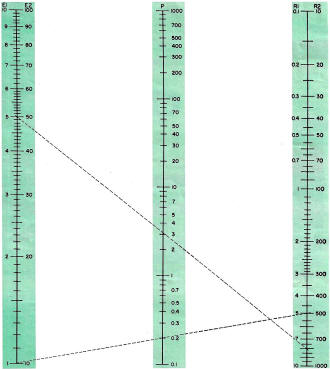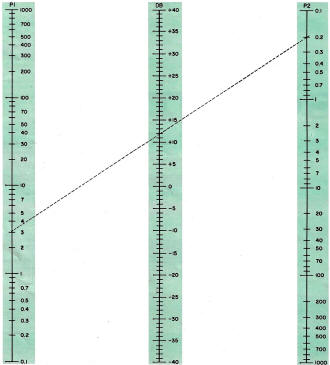|
August 1962 Electronics World
 Table of Contents
Table of Contents
Wax nostalgic about and learn from the history of early electronics. See articles
from
Electronics World, published May 1959
- December 1971. All copyrights hereby acknowledged.
|
August 1962 was a good month
for lovers of nomographs and infographics. Electronics World magazine published
three articles feeding the mania, including this one,
Sound
| Audio | Music Infographic, and
Coil-Winding Charts.
All make good printed references to keep on-hand. One nomograph converts the ratio
of two power levels (in watts, milliwatts, etc.) to equivalent decibels of gain.
It can also be used to find the unknown power level if one is known and the gain
in dB is known. The other nomograph facilitates graphically calculating voltage
or power based on the source resistance (assumed to have only real components; i.e.,
no complex values). If you are not sure how to keep units constant for voltage,
power, and resistance (milli, micro, etc.), calculate using the base units and then
convert afterward.
Versatile Voltage, Power, and Decibel Nomograms
By Jim Kyle

Chart 1 - Voltage to power conversion nomograph.
Two useful charts that enable the audio technician to find amplifier gains and
losses even when voltage measurements are taken across different impedances.
Calculations of power levels and decibel ratios from voltage readings often lead
to confusion for both experienced technicians and beginners, since the conventional
formula for determining decibel ratio from voltage readings assumes that each reading
is taken at the same impedance level.
Many charts, tables, and graphs have been published to aid in solving such problems.
However, the charts shown here offer features not to be found in such previous aids.
With them, power corresponding to any voltage reading can be determined if resistance
is known, voltage can be determined if power is known, and the gain or loss in decibels
of any equipment can be determined if input and output voltages and resistance can
be measured.

Chart 2 - Power (watts) ratio to decibels conversion nomograph.
Chart 1 is used for voltage-power-resistance calculations. Chart 2 converts power
levels directly to decibels gain or loss.
The voltage and resistance scales of Chart 1 bear two sets of graduations, labeled
E1 and R1 and E2 and R2 respectively. Scales bearing the same suffix number are
used together.
For example, suppose an amplifier is under test. A 10-volt signal applied to
the 500-ohm input produces an output measured at 5 volts across 8 ohms.
First, determine input power from Chart 1. The line connecting 10 volts (E2 scale)
and 500 ohms (R2 scale) passes through 0.2 watt. Output power is next. This time,
the E1 and R1 scales of Chart 1 are used, yielding an answer of 3.1 watts.
Now we turn to Chart 2. Connecting the 3.1-watt output (PI scale) and the 0.2-watt
input (P2 scale) gives a total amplifier gain of just under 12 decibels.
Nomographs / Nomograms Available on RF Cafe:
-
Parallel Series Resistance Calculator
-
Transformer Turns Ratio Nomogram
-
Symmetrical T and H Attenuator Nomograph
-
Amplifier Gain Nomograph
-
Decibel
Nomograph
-
Voltage and Power Level Nomograph
-
Nomograph Construction
-
Nomogram Construction for Charts with Complicating Factors or Constants
-
Link Coupling Nomogram
-
Multi-Layer Coil Nomograph
-
Delay Line Nomogram
-
Voltage, Current, Resistance, and Power Nomograph
-
Resistor Selection Nomogram
-
Resistance and Capacitance Nomograph
-
Capacitance Nomograph
-
Earth
Curvature Nomograph
-
Coil Winding Nomogram
-
RC Time-Constant Nomogram
-
Coil Design
Nomograph
-
Voltage, Power, and Decibel Nomograph
-
Coil Inductance Nomograph
-
Antenna Gain Nomograph
-
Resistance and Reactance Nomograph
-
Frequency / Reactance Nomograph
Posted June 21, 2021











